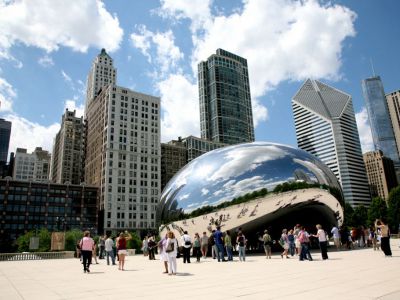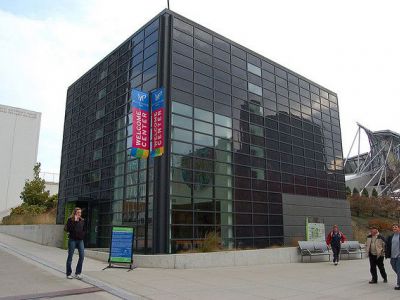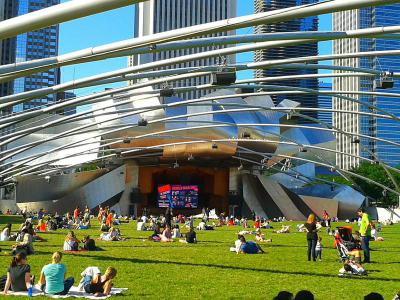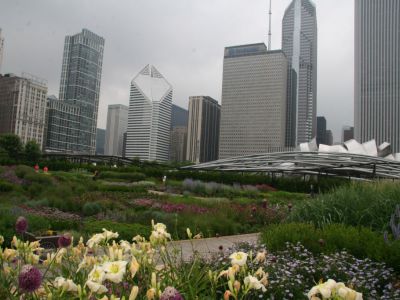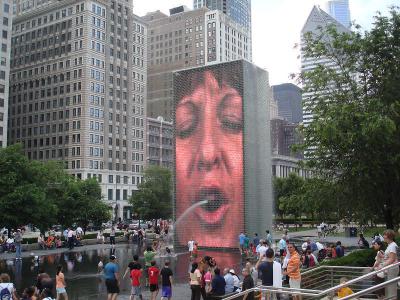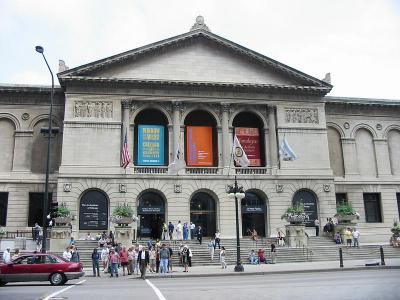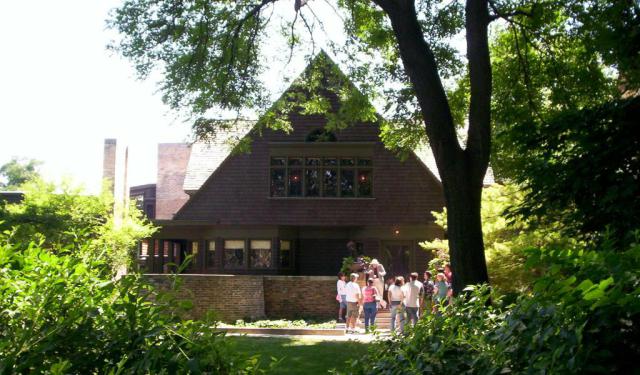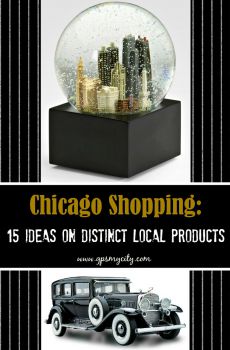
Millennium and Grant Parks Walking Tour (Self Guided), Chicago
The city of Chicago is renowned for its outdoor green spaces. One such “forever free and open” space, is called Grant Park and was established in 1844. In fact, upon foundation, it was called Lake Park, but was renamed in 1901 after the American Civil War General and United States President, Ulysses S. Grant.
Popularly referred to as “Chicago's front lawn,” this lakefront park is the site of many of summer festivals, including Blues Fest, Taste of Chicago, and Lollapalooza. Among other notable features here are the Clarence Buckingham Fountain, the Art Institute of Chicago, and a monument to the 16th president of the United States, Abraham Lincoln.
In 2004, a section of northern Grant Park was redeveloped as Millennium Park which today accommodates four artistic highlights: the Jay Pritzker Pavilion, Cloud Gate, Crown Fountain, and the Lurie Garden.
In essence, Grant Park represents Chicago's progressive design streak spanning from the 19th century to the 21st. To explore the park's architectural and historic features in more detail, take this self-guided walk!
Popularly referred to as “Chicago's front lawn,” this lakefront park is the site of many of summer festivals, including Blues Fest, Taste of Chicago, and Lollapalooza. Among other notable features here are the Clarence Buckingham Fountain, the Art Institute of Chicago, and a monument to the 16th president of the United States, Abraham Lincoln.
In 2004, a section of northern Grant Park was redeveloped as Millennium Park which today accommodates four artistic highlights: the Jay Pritzker Pavilion, Cloud Gate, Crown Fountain, and the Lurie Garden.
In essence, Grant Park represents Chicago's progressive design streak spanning from the 19th century to the 21st. To explore the park's architectural and historic features in more detail, take this self-guided walk!
How it works: Download the app "GPSmyCity: Walks in 1K+ Cities" from Apple App Store or Google Play Store to your mobile phone or tablet. The app turns your mobile device into a personal tour guide and its built-in GPS navigation functions guide you from one tour stop to next. The app works offline, so no data plan is needed when traveling abroad.
Millennium and Grant Parks Walking Tour Map
Guide Name: Millennium and Grant Parks Walking Tour
Guide Location: USA » Chicago (See other walking tours in Chicago)
Guide Type: Self-guided Walking Tour (Sightseeing)
# of Attractions: 10
Tour Duration: 2 Hour(s)
Travel Distance: 2.7 Km or 1.7 Miles
Author: doris
Sight(s) Featured in This Guide:
Guide Location: USA » Chicago (See other walking tours in Chicago)
Guide Type: Self-guided Walking Tour (Sightseeing)
# of Attractions: 10
Tour Duration: 2 Hour(s)
Travel Distance: 2.7 Km or 1.7 Miles
Author: doris
Sight(s) Featured in This Guide:
- Cloud Gate
- Wrigley Square and Millennium Monument
- Exelon Pavilions
- Jay Pritzker Pavilion
- BP Pedestrian Bridge
- Maggie Daley Park
- Lurie Garden
- Crown Fountain
- Art Institute of Chicago
- Buckingham Fountain
1) Cloud Gate (must see)
Situated at the heart of AT&T Plaza within Millennium Park, Cloud Gate was created during the years 2004 to 2006, under the artistic vision of Anish Kapoor, an Indian-born British sculptor renowned for his large-scale outdoor artworks, many of which feature highly reflective surfaces. This sculpture marked Kapoor's inaugural foray into public outdoor art in the U.S., standing as his most iconic creation.
Crafted entirely from stainless steel, this monumental work meticulously joined 168 plates, expertly polished to conceal any visible seams. Towering over three stories tall, it spans 66 feet in length, 33 in height, and 42 in width, with a weight of 100 tons. Locals affectionately refer to it as "The Bean", though its design was actually inspired by the shape of a mercury droplet. With its concave underside, it conjures a funhouse mirror effect for those who venture beneath, reflecting captivatingly distorted images of the Chicago skyline.
Before its installation, Cloud Gate stirred controversy among experts, some of whom doubted its feasibility due to the technical challenges related to construction, assembly, maintenance, and upkeep. While a viable solution was eventually devised, the project experienced delays and was still unfinished when Millennium Park opened in 2004. The formal dedication of Cloud Gate took place on May 15, 2006, following its completion, and it has since garnered widespread acclaim both domestically and internationally.
Why You Should Visit:
Taking a selfie in front of this captivating artwork, which mirrors the surrounding skyline, has become an iconic Chicago souvenir.
Crafted entirely from stainless steel, this monumental work meticulously joined 168 plates, expertly polished to conceal any visible seams. Towering over three stories tall, it spans 66 feet in length, 33 in height, and 42 in width, with a weight of 100 tons. Locals affectionately refer to it as "The Bean", though its design was actually inspired by the shape of a mercury droplet. With its concave underside, it conjures a funhouse mirror effect for those who venture beneath, reflecting captivatingly distorted images of the Chicago skyline.
Before its installation, Cloud Gate stirred controversy among experts, some of whom doubted its feasibility due to the technical challenges related to construction, assembly, maintenance, and upkeep. While a viable solution was eventually devised, the project experienced delays and was still unfinished when Millennium Park opened in 2004. The formal dedication of Cloud Gate took place on May 15, 2006, following its completion, and it has since garnered widespread acclaim both domestically and internationally.
Why You Should Visit:
Taking a selfie in front of this captivating artwork, which mirrors the surrounding skyline, has become an iconic Chicago souvenir.
2) Wrigley Square and Millennium Monument
Nestled on the corner of Michigan Avenue and Randolph Street, in the northwest part of Chicago's Millennium Park, Wrigley Square is a tree-lined, public area serving as an outdoor exhibit and performance space. Inviting to those who seek relaxation amid its large lawn, fountain, and stroll paths, this square also has a reputation as a vibrant place for cultural events such as art shows, photography displays, and occasional live music performances.
Anchoring the square is the Millennium Monument, a nearly full-sized replica of the original peristyle that once stood in this section of Grant Park, from 1917 until 1953 (when it was dismantled to make room for a parking lot). With its graceful semi-circular row of 40-foot Doric-style limestone columns, this monument elegantly contributes to the Michigan Avenue designation as a landmark district.
Etched in stone on the monument's base are the names of 122 founders of Millennium Park – private and corporate donors, who supported its design, construction, and ongoing art and architecture curation. In 2017, the structure was artistically enhanced with LED color-changing lighting, new pre-cast concrete elements, and new pavers for the fountain plaza at its base.
Anchoring the square is the Millennium Monument, a nearly full-sized replica of the original peristyle that once stood in this section of Grant Park, from 1917 until 1953 (when it was dismantled to make room for a parking lot). With its graceful semi-circular row of 40-foot Doric-style limestone columns, this monument elegantly contributes to the Michigan Avenue designation as a landmark district.
Etched in stone on the monument's base are the names of 122 founders of Millennium Park – private and corporate donors, who supported its design, construction, and ongoing art and architecture curation. In 2017, the structure was artistically enhanced with LED color-changing lighting, new pre-cast concrete elements, and new pavers for the fountain plaza at its base.
3) Exelon Pavilions
The Exelon Pavilions, which cost $7 million and were constructed in 2004, can be found within Millennium Park and utilize state-of-the art photovoltaic technology to generate enough electricity each year to power 16 energy-efficient homes. The North Pavilions, which are sleek black cubes, were designed to complement the adjacent Harris Theater for Music and Dance, designed by Driehaus Prize winner Thomas Beeby. One of these pavilions serves as a Welcome Center, while the other provides pedestrian access to the underground parking garages. Both are notable for having the first electricity-generating curtain walls in the Midwest.
On the park's southern end, there are two smaller Exelon Pavilions, designed by architect Renzo Piano, featuring limestone and clear glass to harmonize with The Art Institute's forthcoming expansion. Blair Kamin, the Pulitzer Prize-winning architecture critic for the Chicago Tribune, commended the decision to enlist architects for the design of the pavilions, deeming it a brilliant choice. He speculated that if contractors had been responsible for the designs, Millennium Park might have featured uninspiring, purely utilitarian structures instead. Kamin expressed his satisfaction with Renzo Piano's South Pavilions, characterizing them as small yet exquisite examples of modernist architecture, "almost resembling houses", and awarded them a 3-star rating out of a possible 4, indicating a "very good" evaluation.
On the park's southern end, there are two smaller Exelon Pavilions, designed by architect Renzo Piano, featuring limestone and clear glass to harmonize with The Art Institute's forthcoming expansion. Blair Kamin, the Pulitzer Prize-winning architecture critic for the Chicago Tribune, commended the decision to enlist architects for the design of the pavilions, deeming it a brilliant choice. He speculated that if contractors had been responsible for the designs, Millennium Park might have featured uninspiring, purely utilitarian structures instead. Kamin expressed his satisfaction with Renzo Piano's South Pavilions, characterizing them as small yet exquisite examples of modernist architecture, "almost resembling houses", and awarded them a 3-star rating out of a possible 4, indicating a "very good" evaluation.
4) Jay Pritzker Pavilion
The Jay Pritzker Pavilion serves as the central attraction within the Millennium Park, functioning as an open-air concert venue. Designed by Frank Gehry, it takes the form of an urban-scale sculpture that seems to almost take flight from the sunken theater beneath it. The stage features twelve flowing ribbons crafted from steel-plated aluminum, forming a playful "headdress" that reaches a height of 120 feet. Additionally, a colossal steel pipe trellis stretches over the 4,000-seat amphitheater and the expansive 7,000-capacity Great Lawn. This trellis supports an advanced sound system specially engineered to replicate the acoustic qualities of an indoor concert hall, marking the first permanent installation of its kind in the United States.
Throughout the summer and early fall, the pavilion hosts a series of free concerts, ranging from the classical Grant Park Music Festival featuring the resident Grant Park Orchestra to performances of world music, blues, and jazz.
Why You Should Visit:
Exceptional outdoor theater experience: interesting design, cutting-edge acoustics, ample seating options (including both seats and a spacious lawn), an expansive stage featuring a massive video screen, and conveniently located restroom facilities nearby. The majority of performances are free and attract large audiences, offering a diverse range of entertainment options.
Tip:
Check the event schedule in advance and consider arriving early or purchasing tickets for seating. While the park in front can be an alternative for enjoying the shows, keep in mind that the sound quality may not be as pristine as in the designated seating areas.
Throughout the summer and early fall, the pavilion hosts a series of free concerts, ranging from the classical Grant Park Music Festival featuring the resident Grant Park Orchestra to performances of world music, blues, and jazz.
Why You Should Visit:
Exceptional outdoor theater experience: interesting design, cutting-edge acoustics, ample seating options (including both seats and a spacious lawn), an expansive stage featuring a massive video screen, and conveniently located restroom facilities nearby. The majority of performances are free and attract large audiences, offering a diverse range of entertainment options.
Tip:
Check the event schedule in advance and consider arriving early or purchasing tickets for seating. While the park in front can be an alternative for enjoying the shows, keep in mind that the sound quality may not be as pristine as in the designated seating areas.
5) BP Pedestrian Bridge
In addition to his work on the Jay Pritzker Pavilion, Frank Gehry lent his creative touch to the sinuous, stainless-steel BP Bridge, which serves as a link between Millennium Park and Daley Bicentennial Plaza on the eastern side of Columbus Drive, while also acting as an acoustic barrier separating the aforementioned Pritzker Pavilion from the traffic on Columbus. Surprisingly, the "BP" abbreviation doesn't reference "Bicentennial Plaza"; rather, it honors the energy giant British Petroleum, which generously donated $5 million toward the construction of this remarkable 960-foot-long structure.
Gehry was the sole contender considered for this project and agreed to take it on once the Pritzker family had secured the necessary funding. Resembling the sinuous form of a snake, its design inspiration is said to have been derived from the live carp that the architect's Jewish grandmother used to purchase at a Toronto fish market.
Engineered to bear a substantial load without experiencing structural issues due to its own weight, the bridge was lauded for its aesthetics and has received recognition for its innovative use of sheet metal, particularly stainless steel plates. These materials evoke biomorphic references that are characteristic of Gehry's distinctive style.
Why You Should Visit:
On a beautiful day, this bridge offers one of the most picturesque strolls you can experience in Chicago. Its broad, sinuous pathway continually presents opportunities to appreciate the city's skyline and the vistas of Lake Michigan, as well as providing delightful views of both Millennium Park and Maggie Daley Park.
Gehry was the sole contender considered for this project and agreed to take it on once the Pritzker family had secured the necessary funding. Resembling the sinuous form of a snake, its design inspiration is said to have been derived from the live carp that the architect's Jewish grandmother used to purchase at a Toronto fish market.
Engineered to bear a substantial load without experiencing structural issues due to its own weight, the bridge was lauded for its aesthetics and has received recognition for its innovative use of sheet metal, particularly stainless steel plates. These materials evoke biomorphic references that are characteristic of Gehry's distinctive style.
Why You Should Visit:
On a beautiful day, this bridge offers one of the most picturesque strolls you can experience in Chicago. Its broad, sinuous pathway continually presents opportunities to appreciate the city's skyline and the vistas of Lake Michigan, as well as providing delightful views of both Millennium Park and Maggie Daley Park.
6) Maggie Daley Park
Maggie Daley Park's undulating terrain and meandering pathways create a striking contrast to Grant Park to the south, which follows a more formal layout. This unique design offers a diverse range of open spaces and active recreation areas, making the park not only a destination in itself but also a vital link connecting Millennium Park and the lakefront. Few hints, like the presence of air vents from the 1970s, reveal that this sprawling 27-acre park is built atop a 4,000-car garage, essentially functioning as an expansive green roof.
A vast expanse of open lawns forms a "valley" that extends diagonally from the southwest corner to the northeast. This open area offers awe-inspiring views of the city and is intersected by elegantly meandering pathways that seamlessly blend with the landing area of the BP Bridge. To the northwest, you'll discover the skating ribbon and climbing wall, while in the southeast, a charming children's play garden is nestled among the trees.
The park embodies a delightful blend of tranquility and playfulness, merging elements of nature with human-made structures. Towering light masts, resembling giant tripods, line the meandering paths. These masts are designed to cast a gentle moonlight glow over the park at night, although they stand out prominently against the landscape. Only time will tell if the impact of these features, as well as some of the larger structures, will be softened by the growth of mature trees.
Why You Should Visit:
This newer park offers a plethora of outdoor activities, including rock-climbing walls, miniature golf, and the irresistible skating ribbon, which transforms into an ice skating rink in winter and accommodates roller skates and scooters in warmer months. All of these attractions are entirely free, and you can savor fantastic views of Lake Michigan and the Chicago city skyline from an elevation of 40 feet!
A vast expanse of open lawns forms a "valley" that extends diagonally from the southwest corner to the northeast. This open area offers awe-inspiring views of the city and is intersected by elegantly meandering pathways that seamlessly blend with the landing area of the BP Bridge. To the northwest, you'll discover the skating ribbon and climbing wall, while in the southeast, a charming children's play garden is nestled among the trees.
The park embodies a delightful blend of tranquility and playfulness, merging elements of nature with human-made structures. Towering light masts, resembling giant tripods, line the meandering paths. These masts are designed to cast a gentle moonlight glow over the park at night, although they stand out prominently against the landscape. Only time will tell if the impact of these features, as well as some of the larger structures, will be softened by the growth of mature trees.
Why You Should Visit:
This newer park offers a plethora of outdoor activities, including rock-climbing walls, miniature golf, and the irresistible skating ribbon, which transforms into an ice skating rink in winter and accommodates roller skates and scooters in warmer months. All of these attractions are entirely free, and you can savor fantastic views of Lake Michigan and the Chicago city skyline from an elevation of 40 feet!
7) Lurie Garden
Located just south of the expansive Great Lawn, the 2.5-acre Lurie Garden represents a bold departure from conventional garden design and the natural landscape ideals popularized by Frederick Law Olmsted in the late 19th century. Instead, it embraces the use of 130 native plant species to craft a lush and tranquil prairie oasis in the heart of the city. This collaborative creation by Kathryn Gustafson of Seattle, Piet Oudolf of the Netherlands, and Robert Israel of Los Angeles features a striking 15-foot-tall "shoulder hedge" at its center, dramatically illuminated—a tribute to Carl Sandburg's depiction of Chicago as the "stormy, husky, brawling, City of the Big Shoulders."
Meanwhile, The Seam boardwalk traces the historical contours of the lake's retaining walls, effectively separating the Dark Plate (representing the marshy past with shade-loving plant varieties and a mix of trees creating a canopy), from the Light Plate, characterized by sun-loving perennials and controlled natural elements.
For those interested in exploring Lurie Garden and its diverse plant life more intimately, guided tours are available on Sundays from mid-May through September. These tours depart from the BP Bridge every fifteen minutes, starting at 10am and concluding at 1pm.
Why You Should Visit:
A splendid instance of an urban garden adorned with native flora, offering a tranquil ambiance set against the backdrop of amazing and distinctive skyscrapers. It maintains a manageable size and is designed for easy navigation. Notably, Green Roofs for Healthy Cities has officially recognized this park as "the largest green roof in the world".
Tip:
Don't miss the opportunity to rejuvenate your feet on a scorching day by dipping them in the refreshing stream!
Meanwhile, The Seam boardwalk traces the historical contours of the lake's retaining walls, effectively separating the Dark Plate (representing the marshy past with shade-loving plant varieties and a mix of trees creating a canopy), from the Light Plate, characterized by sun-loving perennials and controlled natural elements.
For those interested in exploring Lurie Garden and its diverse plant life more intimately, guided tours are available on Sundays from mid-May through September. These tours depart from the BP Bridge every fifteen minutes, starting at 10am and concluding at 1pm.
Why You Should Visit:
A splendid instance of an urban garden adorned with native flora, offering a tranquil ambiance set against the backdrop of amazing and distinctive skyscrapers. It maintains a manageable size and is designed for easy navigation. Notably, Green Roofs for Healthy Cities has officially recognized this park as "the largest green roof in the world".
Tip:
Don't miss the opportunity to rejuvenate your feet on a scorching day by dipping them in the refreshing stream!
8) Crown Fountain
To the south of Tribune Plaza, you'll encounter Crown Fountain, a striking installation designed by the renowned Spanish architect Jaume Plensa. Comprising two impressive 50-foot (15.2-meter) glass towers that face each other across a granite plaza, this fountain is a unique attraction. Beneath the surface of the glass blocks, LED screens display a rotating gallery of close-up images featuring 1,000 Chicago residents. These individuals, drawn from various communities within the city, were asked to simulate blowing on a feather while being filmed. Now, when their digital representations purse their lips, water playfully spouts from their mouths, bringing joy to playful children. In the summertime, it transforms into a popular splash park, but even during Chicago's winters, the fountain retains its lifelike charm.
The atmosphere surrounding Crown Fountain is infectious, drawing people from diverse backgrounds and fostering an extraordinary sense of community. It's the kind of place that transcends social boundaries and unites people, if only for a brief moment. The sight of strangers-turned-friends sharing laughter as they dodge the dancing water spouts is bound to bring a smile to your face.
Why You Should Visit:
Whether you want to bask in the sun, enjoy a picnic, or simply take a leisurely stroll, everything is readily available here. The area is consistently well-maintained, with crystal-clear water and meticulously kept grounds. It's evident that the city takes great pride in preserving the beauty of this location, and this commitment shines through in every aspect.
The atmosphere surrounding Crown Fountain is infectious, drawing people from diverse backgrounds and fostering an extraordinary sense of community. It's the kind of place that transcends social boundaries and unites people, if only for a brief moment. The sight of strangers-turned-friends sharing laughter as they dodge the dancing water spouts is bound to bring a smile to your face.
Why You Should Visit:
Whether you want to bask in the sun, enjoy a picnic, or simply take a leisurely stroll, everything is readily available here. The area is consistently well-maintained, with crystal-clear water and meticulously kept grounds. It's evident that the city takes great pride in preserving the beauty of this location, and this commitment shines through in every aspect.
9) Art Institute of Chicago (must see)
Perched atop a grand set of stone steps and guarded by its iconic lion statues, you'll discover the Midwest's most extensive art museum. Within the colossal Beaux-Arts structure, this institution proudly displays an expansive array of artworks from diverse regions worldwide. It is notably enhanced by a comprehensive assortment of modern and contemporary pieces featured in the Modern Wing, an architectural marvel designed by the renowned Italian architect, Renzo Piano.
Organized chronologically, the extensive European Collection spans from the Middle Ages to 1950, encompassing a substantial assortment of Renaissance and Baroque art and sculptures. Yet, its primary attraction lies in its nearly 400 Impressionist and Post-Impressionist paintings. Meanwhile, the American Arts collection comprises approximately 5,500 paintings and sculptures spanning from the 1600s to 1950. Additionally, the loans from the Terra Foundation collection encompass paintings and works on paper, as well as a diverse range of decorative arts, including furniture, glass, and ceramics from the 18th century to the present (notably, the silver collection stands out). Among the must-see attractions are beloved Chicago gems such as the Thorne Miniature Room and Chagall's remarkable stained-glass creation, "American Windows".
Why You Should Visit:
The diverse collection encompasses paintings, drawings, sculptures, and designs that span from ancient times to the contemporary world. Visitors will have the opportunity to explore a rich array of artworks from various eras and regions, including Greek, Roman, Byzantine, European, Asian, African, and Native American art. Additionally, you can delve into the museum's extensive and comprehensive photography collection, making it a truly enriching cultural experience.
Organized chronologically, the extensive European Collection spans from the Middle Ages to 1950, encompassing a substantial assortment of Renaissance and Baroque art and sculptures. Yet, its primary attraction lies in its nearly 400 Impressionist and Post-Impressionist paintings. Meanwhile, the American Arts collection comprises approximately 5,500 paintings and sculptures spanning from the 1600s to 1950. Additionally, the loans from the Terra Foundation collection encompass paintings and works on paper, as well as a diverse range of decorative arts, including furniture, glass, and ceramics from the 18th century to the present (notably, the silver collection stands out). Among the must-see attractions are beloved Chicago gems such as the Thorne Miniature Room and Chagall's remarkable stained-glass creation, "American Windows".
Why You Should Visit:
The diverse collection encompasses paintings, drawings, sculptures, and designs that span from ancient times to the contemporary world. Visitors will have the opportunity to explore a rich array of artworks from various eras and regions, including Greek, Roman, Byzantine, European, Asian, African, and Native American art. Additionally, you can delve into the museum's extensive and comprehensive photography collection, making it a truly enriching cultural experience.
10) Buckingham Fountain (must see)
Situated at the very heart of the city's bustling downtown business district, Grant Park boasts an exquisite centerpiece. This fountain, one of the largest in the world, was generously presented to Chicago by the philanthropic Kate Sturges Buckingham in honor of her brother. Both siblings were passionate art collectors, as their family had amassed wealth through a grain elevator business.
Crafted in the classical Fine Arts style, this fountain is a sculptural masterpiece resembling a three-tiered wedding cake, adorned with intricate pink-marble seashell motifs, whimsical water-spouting fish, and four bronze sculptures of sea horses, symbolizing the four states surrounding Lake Michigan. Its construction in 1927 drew inspiration from a fountain in Versailles, though it is about twice the size.
For the most captivating experience, visit the fountain from early May to mid-October when it dazzles with elaborate nighttime illumination, casting vibrant hues upon its waters. Stay a while, and you'll be treated to a spectacular show that occurs every hour on the hour, with the central water jet soaring an impressive 150 feet into the sky.
Tip:
Notable statues in close proximity are also worth your attention. Just west of the fountain, across Columbus Avenue, you'll find the seated Lincoln statue, positioned atop a pedestal, surveying the park. Created by Augustus Saint-Gaudens, this statue was unveiled in 1926 and exudes a more subdued presence. Along Congress Parkway near Michigan Avenue, you'll encounter The Bowman and the Spearman, a remarkable pair of 17-foot-tall bronze Indian warriors sculpted by Ivan Mestrovic.
Crafted in the classical Fine Arts style, this fountain is a sculptural masterpiece resembling a three-tiered wedding cake, adorned with intricate pink-marble seashell motifs, whimsical water-spouting fish, and four bronze sculptures of sea horses, symbolizing the four states surrounding Lake Michigan. Its construction in 1927 drew inspiration from a fountain in Versailles, though it is about twice the size.
For the most captivating experience, visit the fountain from early May to mid-October when it dazzles with elaborate nighttime illumination, casting vibrant hues upon its waters. Stay a while, and you'll be treated to a spectacular show that occurs every hour on the hour, with the central water jet soaring an impressive 150 feet into the sky.
Tip:
Notable statues in close proximity are also worth your attention. Just west of the fountain, across Columbus Avenue, you'll find the seated Lincoln statue, positioned atop a pedestal, surveying the park. Created by Augustus Saint-Gaudens, this statue was unveiled in 1926 and exudes a more subdued presence. Along Congress Parkway near Michigan Avenue, you'll encounter The Bowman and the Spearman, a remarkable pair of 17-foot-tall bronze Indian warriors sculpted by Ivan Mestrovic.
Walking Tours in Chicago, Illinois
Create Your Own Walk in Chicago
Creating your own self-guided walk in Chicago is easy and fun. Choose the city attractions that you want to see and a walk route map will be created just for you. You can even set your hotel as the start point of the walk.
Chicago Introduction Walking Tour
Chicago, perched on the shores of Lake Michigan in Illinois, is a city steeped in history and urban vibrancy. Known by numerous nicknames such as the Windy City and the City of Big Shoulders, it boasts a skyline marked by towering structures. The area of today's Chicago, initially inhabited by Native American tribes, saw its first European-settled reference as "Chicagou" in 1679, a... view more
Tour Duration: 2 Hour(s)
Travel Distance: 3.9 Km or 2.4 Miles
Tour Duration: 2 Hour(s)
Travel Distance: 3.9 Km or 2.4 Miles
Chicago Chinatown Walking Tour
Tucked away just south of the Loop, the Chinatown of Chicago was established in 1912 and is considered one of the best examples of American Chinatown. While it may be one of Chicago’s smallest neighborhoods geographically, it is big on character, colors, sights, sounds, and flavors. Here, you’ll find a wide range of unique boutiques, specialty shops, religious sights, authentic Chinese... view more
Tour Duration: 1 Hour(s)
Travel Distance: 1.7 Km or 1.1 Miles
Tour Duration: 1 Hour(s)
Travel Distance: 1.7 Km or 1.1 Miles
University of Chicago Walking Tour
Founded in 1890, the University of Chicago is among the world’s most prestigious educational institutions. As of 2020, the University’s students, faculty and staff have included 100 Nobel laureates, giving it the fourth-most affiliated Nobel laureates of any university.
Set in the heart of Chicago’s famous eclectic neighborhood, Hyde Park, the campus is worth a visit as it offers a... view more
Tour Duration: 2 Hour(s)
Travel Distance: 2.5 Km or 1.6 Miles
Set in the heart of Chicago’s famous eclectic neighborhood, Hyde Park, the campus is worth a visit as it offers a... view more
Tour Duration: 2 Hour(s)
Travel Distance: 2.5 Km or 1.6 Miles
Frank Lloyd Wright Architecture Tour in Oak Park
Oak Park, located in Cook County, Illinois, just outside Chicago, made history in 1889 when Frank Lloyd Wright, one of America's most renowned architects, and his wife settled there, leaving a profound impact on the area's appearance. This village boasts the highest concentration of Wright-crafted buildings in the world - over a dozen! - making it a pivotal destination for enthusiasts to... view more
Tour Duration: 2 Hour(s)
Travel Distance: 3.2 Km or 2 Miles
Tour Duration: 2 Hour(s)
Travel Distance: 3.2 Km or 2 Miles
Chicago Navy Pier Walking Tour
Additional to scenic views of the lake, the boats, and the city skyline, the Navy Pier offers a variety of attractions on the waterfront – for kids as well as adults – that draw nearly ten million people annually, making this Chicago's most visited spot. Yes, some may see it as a “tourist trap”, but it is worth the time and money to spend some time here, so take this self-guided walk... view more
Tour Duration: 1 Hour(s)
Travel Distance: 1.0 Km or 0.6 Miles
Tour Duration: 1 Hour(s)
Travel Distance: 1.0 Km or 0.6 Miles
The Magnificent Mile Walking Tour
The stretch of Michigan Avenue from the Chicago River to Lake Shore Drive, otherwise known as the Magnificent Mile, is regarded as one of the world’s great avenues – or Chicago’s version of Fifth Avenue. Take this self-guided walk to explore its whole stretch and surrounding area, featuring a wide selection of amazing stores/malls, world-known museums, restaurants and spectacular... view more
Tour Duration: 3 Hour(s)
Travel Distance: 4.0 Km or 2.5 Miles
Tour Duration: 3 Hour(s)
Travel Distance: 4.0 Km or 2.5 Miles
Useful Travel Guides for Planning Your Trip
Chicago Souvenirs: 15 Distinct Local Products to Bring Home
One of the most fascinating cities in the U.S., if not the whole world, Chicago has no shortage of things closely associated with it, often due to their direct origin (blues, gangstership, etc.), so one might literally be spoiled for choice as to what to choose as a "piece" of Chicago to...
The Most Popular Cities
/ view all
